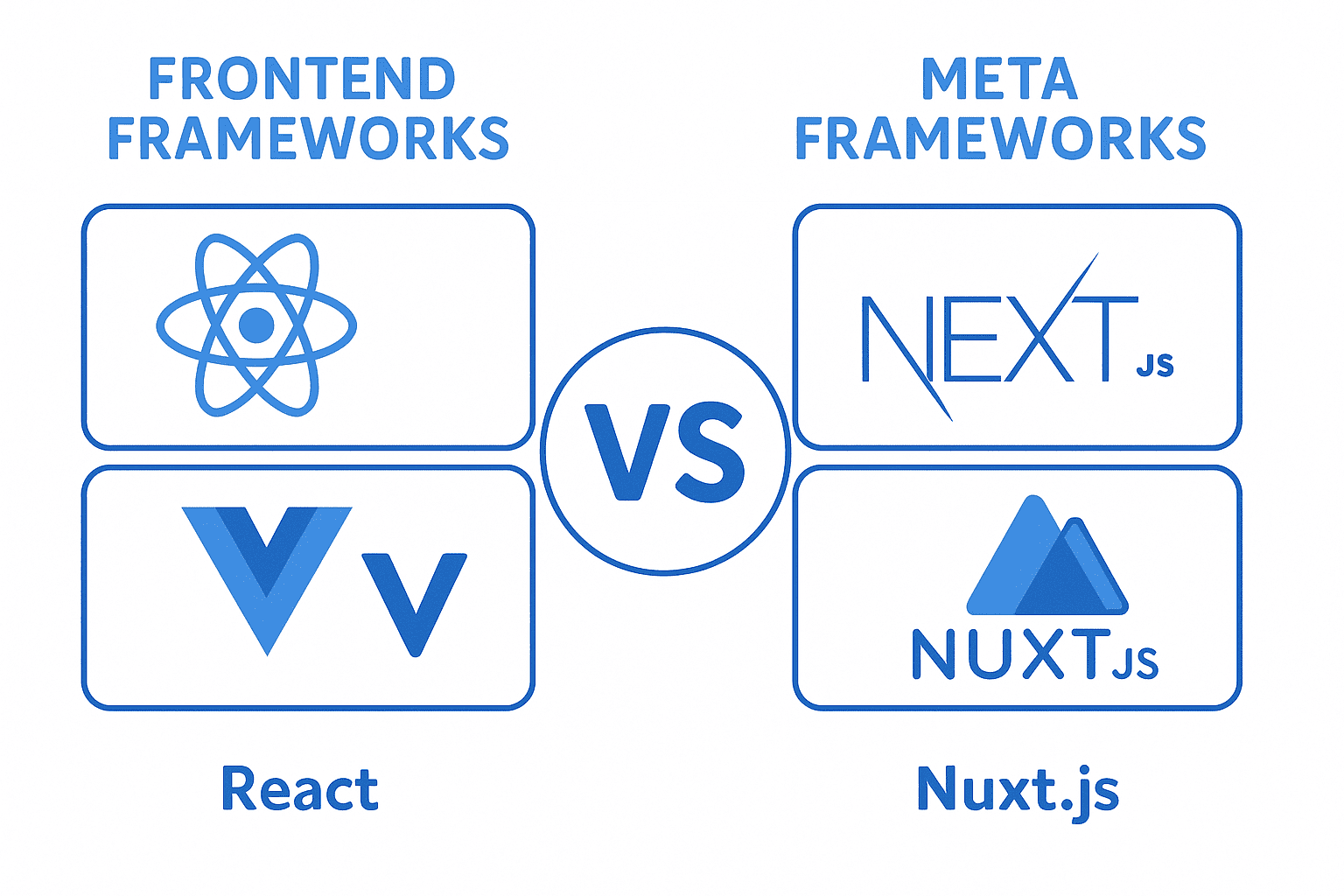When building modern web applications, the choice between React and Next.js often comes up. While Next.js is a powerful framework built on top of React, it’s not always the best fit for every project. In this article, we’ll explore when React alone is sufficient and why Next.js might not always be the ideal choice—helping you make an informed decision based on your project’s needs.
What Is React? And Why It’s Still King
React, developed by Facebook (now Meta), is a JavaScript library for building dynamic user interfaces. At its core, React focuses on component-based development, allowing developers to create reusable UI elements and manage application state efficiently. Its strength lies in its simplicity, flexibility, and vast ecosystem of tools and libraries.
Why React is great for some projects:
- Lightweight: Perfect for small-scale applications like personal blogs, dashboards, or microsites.
- Flexibility: You can use React with any backend (Node.js, Firebase, etc.) or even integrate it into existing projects.
- Community & Ecosystem: A vast ecosystem of tools (e.g., Redux, React Router) and a large community makes it easy to find solutions.
- Learning Curve: Easier for beginners or teams new to front-end development.
For example, a simple personal portfolio with minimal interactivity might not require the overhead of Next.js. React’s simplicity allows developers to focus on the UI and logic without unnecessary complexity.
What Is Next.js? And Why It’s a Game-Changer
Next.js, built by Vercel, is a React framework that adds features like server-side rendering (SSR), static site generation (SSG), and API routes out of the box. It’s designed to simplify full-stack application development by combining React with server-side capabilities, making it ideal for complex projects that demand SEO optimization and performance.
Why Next.js shines:
- SEO-Friendly: SSR ensures search engines can crawl your content, critical for marketing-driven sites.
- Performance: SSG and incremental static regeneration (ISR) improve load times for large-scale apps.
- Full-Stack Capabilities: Built-in API routes and edge functions enable serverless backend functionality.
- Hybrid Architecture: Combines SSR, SSG, and client-side rendering in one framework.
A large e-commerce platform or a content-heavy site (like a blog with dynamic data) often benefits from Next.js’s built-in features, avoiding the need to build custom SSR solutions.
When Is Next.js Better Than React?
Next.js excels in scenarios where SEO, performance, or full-stack capabilities are essential. Here’s when the framework shines:
-
SEO and Performance-Critical Apps
If your project relies on search engine visibility (e.g., a marketing site or product catalog), Next.js’s SSR ensures Google bots can index your content effectively. This is a major advantage over React, which relies on client-side rendering (CSR) and can suffer from poor SEO. -
a Hybrid Application Needs
Next.js allows you to mix SSR, SSG, and CSR in the same project. For example, a news site might use SSG for static articles while dynamically rendering user-specific content with SSR. -
Full-Stack Development
Next.js’s built-in API routes and serverless functions make it ideal for full-stack apps, eliminating the need to set up a separate backend. This is especially useful for startups or developers building MVPs quickly. -
Scalable, Enterprise-Level Projects
For large-scale applications with high traffic and performance demands, Next.js’s optimized rendering strategies (like Incremental Static Regeneration) reduce load times and server costs.
When Is React Better Than Next.js?
While Next.js is powerful, there are scenarios where sticking with React alone is more practical:
-
Simple, Lightweight Projects
For a personal blog or a small dashboard with minimal interactivity, React’s simplicity is preferable. Adding Next.js’s overhead (like server-side rendering and routing) would complicate the project unnecessarily. -
Team Expertise and Project Timeline
If your team is less familiar with Next.js’s conventions (like its file-based routing or API routes), the learning curve could slow development. React, being more straightforward, might be better for teams new to the framework. -
Customization and Flexibility
React’s flexibility allows for greater customization. If your project requires a non-standard setup (e.g., custom server-side logic or unique routing strategies), React gives you more control. Next.js’s opinionated structure might limit this flexibility. -
Existing Infrastructure
If your project already uses a different backend or deployment pipeline, integrating React with existing tools might be more efficient than adopting Next.js’s ecosystem.
Key Considerations: Learning Curve, Performance, and More
- Learning Curve: Next.js has a steeper learning curve due to its additional features. If your team isn’t familiar with SSR or static site generation, the initial setup could be time-consuming.
- Performance Trade-offs: While Next.js optimizes performance, improper configuration (e.g., overusing dynamic rendering) can lead to slower load times. React’s performance relies heavily on how it’s implemented.
- Customization vs. Convention: Next.js provides a structured environment, which might feel restrictive for projects with unique requirements. React’s minimalism makes it easier to adapt to specific use cases.
Conclusion: Choose What Fits Your Project
Next.js is not always better than React. It’s a framework with built-in features that excel in complex, SEO-focused, or full-stack applications. However, for simpler projects, teams new to the ecosystem, or situations requiring maximum flexibility, React alone might be a better fit.
To decide:
- Opt for Next.js if: Your project requires SEO optimization, performance improvements, or full-stack capabilities.
- Choose React if: You need lightweight implementation, have a small team, or prefer maximum customization.
Ultimately, the best choice depends on your project’s goals, your team’s expertise, and the trade-offs between flexibility and built-in tooling. Whether you’re building a simple dashboard or a large-scale app, understanding the strengths of both React and Next.js will help you make the right decision.



